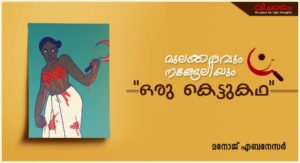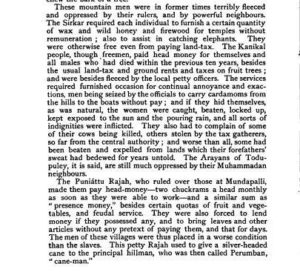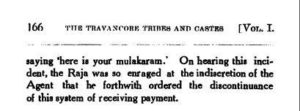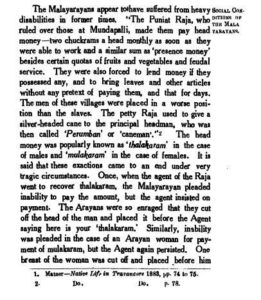
— മനോജ് എബനേസർ —
The poll tax (തലക്കരം/മുലക്കരം).
തിരുവിതാംകൂറിൽ താണ ജാതിക്കാരുടെയിടയിൽ പ്രായപൂർത്തിയായ, അല്ലെങ്കിൽ പണിക്ക് പോവാൻ പ്രായമായവരുടെ തല എണ്ണി ഏർപ്പെടുത്തിയിരുന്ന പ്രതിമാസ കരമാണ് തലക്കരം. ഇത് കേണൽ മൺറോയുടെ ശ്രമഫലമായി നിറുത്തൽ ചെയ്തു എന്നാണ് വിവരം, ആ ചെയ്തതിന്റെ നീട്ട്/വിളമ്പരം ഇതുവരെ കണ്ടുപിടിക്കാൻ സാധിച്ചിട്ടില്ല. There was an oppressive tax regime in Travancore, including the infamous poll tax, or head money, exacted per head on a monthly basis from every low caste person since his attaining maturity/reaching the age of engaging in manual labour. The poll tax was abolished during the period of Col Munro, though the exact neettu or proclamation has not yet been traced. ഇതിനിടെ മുലക്കരം, നങ്ങേലി എന്നൊക്കെ പലരുടെ ഭാവനയ്ക്കനുസരിച്ച് പല കഥകളും നിലവിൽ വന്നിട്ടുണ്ട്. മാറു മറയ്ക്കാൻ വേണ്ടി കൊടുക്കേണ്ട കരമാണ് മുലക്കരം എന്നും, അതു കൊടുക്കാൻ കൂട്ടാക്കാത്ത നങ്ങേലി സ്വന്തം മാറ് അറുത്ത് വാഴയിലയിൽ വച്ചുനീട്ടി എന്നൊക്കെയാണ് കഥ. മാറുമറയ്ക്കാൻ അനുവാദമില്ലായിരുന്നു. എന്നാൽ അനുവാദം കിട്ടാൻ കരം ഉണ്ടായിരുന്നതായോ, നങ്ങേലി സംഭവം നടന്നതായോ ഒരു രേഖയും ആർക്കും ലഭിച്ചിട്ടില്ല. Though the poll tax was real, and the taboo against breast covering was real, there is no  evidence for the alleged payment of tax for the privilege of covering the breasts, which piece of fiction goes by the name of breast-tax. Nor is there any known record from the 19th century about Nangeli, the Ezhava woman from Cherthala who allegedly cut off her own breasts when the tax collector demanded breast tax. എന്നാൽ, തിരുവിതാംകൂറിൽ നിറുത്തൽ ചെയ്ത തലക്കരം ചില ചെറിയ നാട്ടുരാജ്യങ്ങളിൽ പ്രമാണിമാർ ഈടാക്കിയിരുന്നു എന്നും (പടം 1), ഈ തലക്കരം തന്നെ സ്ത്രീകളിൽ നിന്ന് ഈടാക്കുന്നതിന് മുലക്കരം എന്ന വിളിപ്പേര് ഉണ്ടായിരുന്നു എന്നും തെളിവ് ഇതാ (പടം 2, 3). Now here is documentary evidence (Picture 1) that the poll tax that was abolished in Travancore was still exacted in remote corners by petty rajahs (local chieftains), and that the same poll tax was colloquially called ‘breast tax’ when the subjects in question were women (Picture 2, 3).എൽ എം എസിലെ സാമുവൽ മെറ്റീറിന്റെ ‘നേറ്റിവ് ലൈഫ് ഇൻ ട്രാവങ്കൂർ‘ എന്ന പുസ്തകത്തിൽ (പേജ് 78), മല അരയന്മാരും കാണിക്കാരും ഭീകരമായ അടിച്ചമർത്തലുകൾക്ക് വിധേയരായിരുന്നു എന്ന് ചൂണ്ടിക്കാണിക്കുന്നു. പ്രതിഫലം കൂടാതെ സർക്കാരിന് കാട്ടുതേൻ ശേഖരിച്ച് നൽകണം, ആനകളെ പിടിച്ചു കൊടുക്കണം, അവരവർക്കും 10 കൊല്ലത്തിനകം മരിച്ചവർക്കും തലക്കരം നൽകണം. ഇതു കൂടാതെ പ്രാദേശികമായ പ്രമാണിമാർ അവരെക്കൊണ്ട് പല പ്രതിഫലം നൽകാതെയുള്ള പണിയും ചെയ്യിച്ചിരുന്നു – ഉദാഹരണത്തിന്, മലകളിൽ നിന്ന് അവരുടെ വള്ളങ്ങളിലേക്ക് ഏലക്കാ സൗജന്യമായി എത്തിക്കണം, അല്ലെങ്കിൽ പിടികൂടി മർദ്ദിച്ച് ചെയ്യിപ്പിക്കും. കരപ്രമാണിമാർ അവരുടെ മാടുകളെ പിടിച്ചുകൊണ്ടു പോകുമായിരുന്നു, അല്ലെങ്കിൽ അവയെ കൊല്ലും, പ്രതിഫലമില്ലാതെ ജോലി
evidence for the alleged payment of tax for the privilege of covering the breasts, which piece of fiction goes by the name of breast-tax. Nor is there any known record from the 19th century about Nangeli, the Ezhava woman from Cherthala who allegedly cut off her own breasts when the tax collector demanded breast tax. എന്നാൽ, തിരുവിതാംകൂറിൽ നിറുത്തൽ ചെയ്ത തലക്കരം ചില ചെറിയ നാട്ടുരാജ്യങ്ങളിൽ പ്രമാണിമാർ ഈടാക്കിയിരുന്നു എന്നും (പടം 1), ഈ തലക്കരം തന്നെ സ്ത്രീകളിൽ നിന്ന് ഈടാക്കുന്നതിന് മുലക്കരം എന്ന വിളിപ്പേര് ഉണ്ടായിരുന്നു എന്നും തെളിവ് ഇതാ (പടം 2, 3). Now here is documentary evidence (Picture 1) that the poll tax that was abolished in Travancore was still exacted in remote corners by petty rajahs (local chieftains), and that the same poll tax was colloquially called ‘breast tax’ when the subjects in question were women (Picture 2, 3).എൽ എം എസിലെ സാമുവൽ മെറ്റീറിന്റെ ‘നേറ്റിവ് ലൈഫ് ഇൻ ട്രാവങ്കൂർ‘ എന്ന പുസ്തകത്തിൽ (പേജ് 78), മല അരയന്മാരും കാണിക്കാരും ഭീകരമായ അടിച്ചമർത്തലുകൾക്ക് വിധേയരായിരുന്നു എന്ന് ചൂണ്ടിക്കാണിക്കുന്നു. പ്രതിഫലം കൂടാതെ സർക്കാരിന് കാട്ടുതേൻ ശേഖരിച്ച് നൽകണം, ആനകളെ പിടിച്ചു കൊടുക്കണം, അവരവർക്കും 10 കൊല്ലത്തിനകം മരിച്ചവർക്കും തലക്കരം നൽകണം. ഇതു കൂടാതെ പ്രാദേശികമായ പ്രമാണിമാർ അവരെക്കൊണ്ട് പല പ്രതിഫലം നൽകാതെയുള്ള പണിയും ചെയ്യിച്ചിരുന്നു – ഉദാഹരണത്തിന്, മലകളിൽ നിന്ന് അവരുടെ വള്ളങ്ങളിലേക്ക് ഏലക്കാ സൗജന്യമായി എത്തിക്കണം, അല്ലെങ്കിൽ പിടികൂടി മർദ്ദിച്ച് ചെയ്യിപ്പിക്കും. കരപ്രമാണിമാർ അവരുടെ മാടുകളെ പിടിച്ചുകൊണ്ടു പോകുമായിരുന്നു, അല്ലെങ്കിൽ അവയെ കൊല്ലും, പ്രതിഫലമില്ലാതെ ജോലി  ചെയ്തുകൊടുക്കാൻ കഴിയാതെ ഒളിച്ചുപാർക്കുന്ന സ്ത്രീകളെ പിടിച്ച് മർദ്ദിച്ച് മഴയത്തും വെയിലത്തും പൂട്ടിയിട്ട് നിർത്തുകയും, മല അരയന്മാരുടെ നിലങ്ങളെ പിടിച്ചെടുത്ത് അവരെ മർദ്ദിച്ച് അവയിൽ നിന്ന് ഓട്ടിക്കുകയും ചെയ്യുമായിരുന്നു. പൂഞ്ഞാറ്റ് രാജാവ് (ഇത് പന്തളം രാജാവിനെ പോലെ ഒരു പ്രാദേശിക ‘രാജാവ്‘ ആണ്) മല അരയന്മാരിൽ നിന്നും തലക്കരം ഈടാക്കിയിരുന്നു. പണിക്കു പോവാൻ പ്രായമായാൽ പ്രതിമാസം 2 ചക്രം തലക്കരം കൊടുക്കണം. അവരുടെ പഴം പലവ്യഞ്ഞനം എന്നിവയുടെ പങ്ക് കാഴ്ച്ചവക്കണം, പണം കയ്യിലുണ്ടെങ്കിൽ അത് പിടിച്ചുപറിക്കും, ഓലയും മറ്റും ഉണ്ടെങ്കിൽ അതും കൊടുക്കണം. അടിമകളെക്കാൾ ദയനീയമാണ് അവരുടെ അവസ്ഥ എന്ന് മെറ്റീർ പറയുന്നു. Samuel Mateer describes the oppressions and extortions faced by the Mala Arayans and Kanikkars at the hand of the tax collectors and the ‘rajah’ of the petty kingdom of Poonjar (a petty chiefdom just like Pandalam), and concludes that the condition of the Mala Arayans was worse than that of slaves. ചിത്രം 2, 3 എന്നിവ കൃഷ്ണയ്യരുടെ ‘ദ ടാവൻകൂർ ട്രൈബ്സ് ആന്റ് കാസ്റ്റ്സ്‘‘ എന്ന പുസ്തകത്തിൽ നിന്നാണ്. പുരുഷന്മാർക്ക് തലക്കരം എന്നും സ്ത്രീകൾക്ക് മുലക്കരം എന്നും തലവരി അറിയപ്പെട്ടിരുന്നു എന്ന് ഇതിൽ കാണാം. മാറു മറയ്ക്കുന്നതിനുള്ള അവകാശവുമായി ഇതിനു ഒരു ബന്ധവുമില്ല എന്നർഥം. പ്രതിമാസം 2 ചക്രം എന്ന തലക്കരം പിരിക്കാൻ ചെന്ന പൂഞ്ഞാറ്റ് ‘രാജാവിന്റെ‘ മാടമ്പിമാരോട് മലയരയന്മാർ നിസ്സഹായാവസ്ഥ പറഞ്ഞിട്ടും രക്ഷയില്ലാതെ വന്നപ്പോൾ അവർ അയാളുടെ തല വെട്ടി ‘ഇതാ നിങ്ങളുടെ തലക്കരം‘ എന്നുപറഞ്ഞ് കാഴ്ചവച്ചു. കരം കൊടുക്കാൻ നിവൃത്തിയില്ലാത്ത സ്ത്രീയുടെ കരത്തിന് ഇതുപോല നിർബന്ധം പിടിച്ചപ്പോൾ, അവളുടെ ഒരു മുല മുറിച്ച് ഇതുപോലെ വച്ചുകൊടുത്തു, ‘ഇതാ നിങ്ങളുടെ മുലക്കരം‘. ഇതറിഞ്ഞ പൂഞ്ഞാറ്റ് രാജാവ് കരം നിർബന്ധിച്ച്
ചെയ്തുകൊടുക്കാൻ കഴിയാതെ ഒളിച്ചുപാർക്കുന്ന സ്ത്രീകളെ പിടിച്ച് മർദ്ദിച്ച് മഴയത്തും വെയിലത്തും പൂട്ടിയിട്ട് നിർത്തുകയും, മല അരയന്മാരുടെ നിലങ്ങളെ പിടിച്ചെടുത്ത് അവരെ മർദ്ദിച്ച് അവയിൽ നിന്ന് ഓട്ടിക്കുകയും ചെയ്യുമായിരുന്നു. പൂഞ്ഞാറ്റ് രാജാവ് (ഇത് പന്തളം രാജാവിനെ പോലെ ഒരു പ്രാദേശിക ‘രാജാവ്‘ ആണ്) മല അരയന്മാരിൽ നിന്നും തലക്കരം ഈടാക്കിയിരുന്നു. പണിക്കു പോവാൻ പ്രായമായാൽ പ്രതിമാസം 2 ചക്രം തലക്കരം കൊടുക്കണം. അവരുടെ പഴം പലവ്യഞ്ഞനം എന്നിവയുടെ പങ്ക് കാഴ്ച്ചവക്കണം, പണം കയ്യിലുണ്ടെങ്കിൽ അത് പിടിച്ചുപറിക്കും, ഓലയും മറ്റും ഉണ്ടെങ്കിൽ അതും കൊടുക്കണം. അടിമകളെക്കാൾ ദയനീയമാണ് അവരുടെ അവസ്ഥ എന്ന് മെറ്റീർ പറയുന്നു. Samuel Mateer describes the oppressions and extortions faced by the Mala Arayans and Kanikkars at the hand of the tax collectors and the ‘rajah’ of the petty kingdom of Poonjar (a petty chiefdom just like Pandalam), and concludes that the condition of the Mala Arayans was worse than that of slaves. ചിത്രം 2, 3 എന്നിവ കൃഷ്ണയ്യരുടെ ‘ദ ടാവൻകൂർ ട്രൈബ്സ് ആന്റ് കാസ്റ്റ്സ്‘‘ എന്ന പുസ്തകത്തിൽ നിന്നാണ്. പുരുഷന്മാർക്ക് തലക്കരം എന്നും സ്ത്രീകൾക്ക് മുലക്കരം എന്നും തലവരി അറിയപ്പെട്ടിരുന്നു എന്ന് ഇതിൽ കാണാം. മാറു മറയ്ക്കുന്നതിനുള്ള അവകാശവുമായി ഇതിനു ഒരു ബന്ധവുമില്ല എന്നർഥം. പ്രതിമാസം 2 ചക്രം എന്ന തലക്കരം പിരിക്കാൻ ചെന്ന പൂഞ്ഞാറ്റ് ‘രാജാവിന്റെ‘ മാടമ്പിമാരോട് മലയരയന്മാർ നിസ്സഹായാവസ്ഥ പറഞ്ഞിട്ടും രക്ഷയില്ലാതെ വന്നപ്പോൾ അവർ അയാളുടെ തല വെട്ടി ‘ഇതാ നിങ്ങളുടെ തലക്കരം‘ എന്നുപറഞ്ഞ് കാഴ്ചവച്ചു. കരം കൊടുക്കാൻ നിവൃത്തിയില്ലാത്ത സ്ത്രീയുടെ കരത്തിന് ഇതുപോല നിർബന്ധം പിടിച്ചപ്പോൾ, അവളുടെ ഒരു മുല മുറിച്ച് ഇതുപോലെ വച്ചുകൊടുത്തു, ‘ഇതാ നിങ്ങളുടെ മുലക്കരം‘. ഇതറിഞ്ഞ പൂഞ്ഞാറ്റ് രാജാവ് കരം നിർബന്ധിച്ച് പിരിക്കുന്ന രീതി നിറുത്തലാക്കി എന്നും പറയുന്നു. സർക്കാർ നിയോഗിച്ച മനുഷ്യവർഗ്ഗ ശാസ്ത്രജ്ഞനായ ലേഖകൻ തിരുവിതാംകൂർ ചുറ്റിനടന്ന് രേഖപ്പെടുത്തിയ വിവരങ്ങൾ പുസ്തകരൂപത്തിലാക്കി സർക്കാർ പ്രസിദ്ധീകരിച്ചതിലാണ് ഈ വിവരം എന്നതിനാൽ ഒരു എത്നോഗ്രാഫിക് തെളിവായി തന്നെ ഇതിനെ സ്വീകരിക്കാം. എന്നാൽ തെളിവൊന്നും ഇല്ലാത്ത നങ്ങേലി കഥ ഒരുപക്ഷേ ഈ സംഭവവും, ആറ്റിങ്ങൽ റാണി തന്റെ മുൻപിൽ മാറു മറച്ച ഒരു സ്ത്രീയുടെ മുല അറുപ്പിച്ചതും ചേർത്ത് പുതിയ ഒരു ആഖ്യാനം സൃഷ്ടിച്ചതാണോ എന്ന് കണ്ടുപിടിക്കേണ്ടിയിരിക്കുന്നു. Pics 2 and 3, from L A Krishna Iyer’s ‘The Castes and Tribes of Travancore’, clarify that the head tax or poll tax was known as ‘thalakkaram’ in the case of males and as ‘mulakkaram’ in the case of females. In other words, the idea that mulakkaram was a tax on breasts, paid for the privilege of covering the bosom, is wrong, it was simply the colloquial name for female ‘head tax’. Krishna Iyer, a qualified ethnologist commissioned by the Travancore government, goes on to recount the tragedy of two Mala Arayans, one a male, the other a female, who were unable to pay these oppressive taxes to the tax collector sent by the Poonjar ‘rajah’. The extortion of the tax collector so enraged the Mala Arayans that they cut off the head of the man from whom poll tax was demanded and set it in front of the madambis. In the case of the woman too, they cut off one of her breasts and presented it. It is quite probable that this incident, along with that of the Attingal Rani cutting off the breasts of a woman who dared to cover her bosom in the Rani’s presence, got transmuted into the story of Nangeli which is otherwise undocumented. It seems that the Mala Arayan story in this book fits in with the social background and has the ring of plausibility, which Nangeli does not seem to have.
പിരിക്കുന്ന രീതി നിറുത്തലാക്കി എന്നും പറയുന്നു. സർക്കാർ നിയോഗിച്ച മനുഷ്യവർഗ്ഗ ശാസ്ത്രജ്ഞനായ ലേഖകൻ തിരുവിതാംകൂർ ചുറ്റിനടന്ന് രേഖപ്പെടുത്തിയ വിവരങ്ങൾ പുസ്തകരൂപത്തിലാക്കി സർക്കാർ പ്രസിദ്ധീകരിച്ചതിലാണ് ഈ വിവരം എന്നതിനാൽ ഒരു എത്നോഗ്രാഫിക് തെളിവായി തന്നെ ഇതിനെ സ്വീകരിക്കാം. എന്നാൽ തെളിവൊന്നും ഇല്ലാത്ത നങ്ങേലി കഥ ഒരുപക്ഷേ ഈ സംഭവവും, ആറ്റിങ്ങൽ റാണി തന്റെ മുൻപിൽ മാറു മറച്ച ഒരു സ്ത്രീയുടെ മുല അറുപ്പിച്ചതും ചേർത്ത് പുതിയ ഒരു ആഖ്യാനം സൃഷ്ടിച്ചതാണോ എന്ന് കണ്ടുപിടിക്കേണ്ടിയിരിക്കുന്നു. Pics 2 and 3, from L A Krishna Iyer’s ‘The Castes and Tribes of Travancore’, clarify that the head tax or poll tax was known as ‘thalakkaram’ in the case of males and as ‘mulakkaram’ in the case of females. In other words, the idea that mulakkaram was a tax on breasts, paid for the privilege of covering the bosom, is wrong, it was simply the colloquial name for female ‘head tax’. Krishna Iyer, a qualified ethnologist commissioned by the Travancore government, goes on to recount the tragedy of two Mala Arayans, one a male, the other a female, who were unable to pay these oppressive taxes to the tax collector sent by the Poonjar ‘rajah’. The extortion of the tax collector so enraged the Mala Arayans that they cut off the head of the man from whom poll tax was demanded and set it in front of the madambis. In the case of the woman too, they cut off one of her breasts and presented it. It is quite probable that this incident, along with that of the Attingal Rani cutting off the breasts of a woman who dared to cover her bosom in the Rani’s presence, got transmuted into the story of Nangeli which is otherwise undocumented. It seems that the Mala Arayan story in this book fits in with the social background and has the ring of plausibility, which Nangeli does not seem to have.


